14 Malaysian Dishes You Need To Try At Least Once
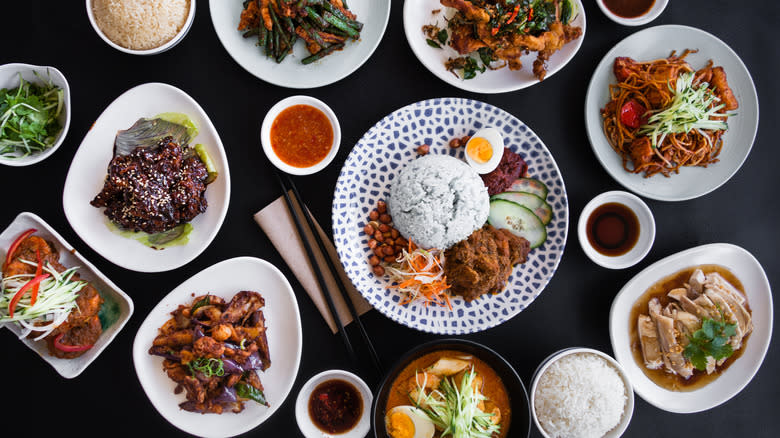
Modern Malaysian food is a celebration of diversity, drawing influence from Malay, Chinese, Indonesian, and Indian culinary cultures. Each of these food traditions brings distinct flavors and cooking techniques, resulting in an array of dishes that reflect Malaysia's multicultural heritage. Malaysian dishes are characterized by their rich and abundant use of aromatic spices and herbs, such as lemongrass, galangal, ginger, and turmeric.
Whether you're exploring the culinary offerings of Malaysia's bustling capital of Kuala Lumpur or the quaint lanes of the country's northeastern state of Penang, every bite is an adventure that is waiting to be savored. One way to do this is to feast on classics such as laksa, a spicy and tangy noodle soup infused with flavors of lemongrass, galangal, and shrimp paste. Equally tempting is Malaysia's iconic char kway teow that is often prepared in smoking woks by street vendors. Whatever you choose, rest assured that you won't be disappointed.
Gearing up for a trip to Malaysia or a dining experience at a Malaysian restaurant? Here's our guide to some of the most memorable Malaysian dishes you need to try at least once.
Read more: 16 Little-Known Facts About Salt
Nasi Lemak
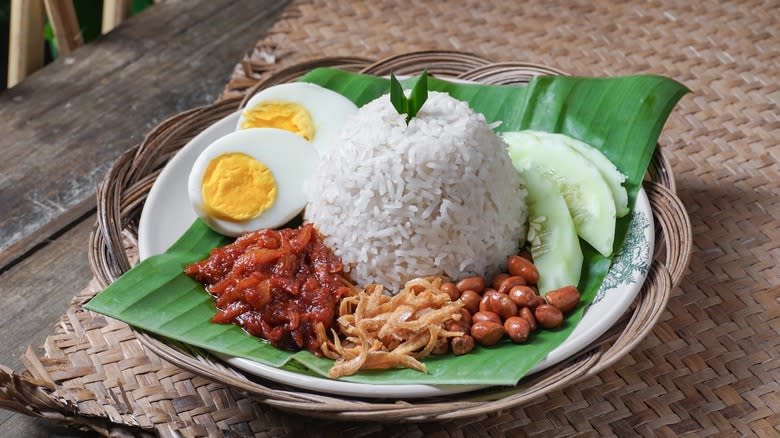
Typically enjoyed for breakfast in Malaysia, the star ingredient of nasi lemak is rice that's cooked in coconut milk, a culinary preparation that imbues it with a bold flavor and creamy texture. The ubiquitous dish, which can be as readily found at Malaysian roadside stalls as upscale hotels, also frequently comes with various side dishes. These traditionally include fried anchovies, a hard-boiled egg, toasted peanuts, and fresh cucumber slices. Nasi lemak is usually accompanied by a condiment like sambal, a spicy chili paste.
Like numerous other culinary classics, nasi lemak has evolved over the years, and today is frequently served with proteins such as beef, chicken, and seafood. These days, the rice is also frequently cooked with additional ingredients, including lemongrass, shallots, ginger, and garlic.
While the exact origins of nasi lemak are unknown, it's believed that the dish has its roots in the agricultural practices of the region, where rice and coconut trees were prevalent. Once cooked, the rice was combined with sides made from other readily available ingredients such as eggs, herbs, and small fish. One of the earliest records of the dish dates back to 1909 when it was mentioned in the writings of a British colonial administrator, Richard Olaf Winstedt.
Nasi Kerabu
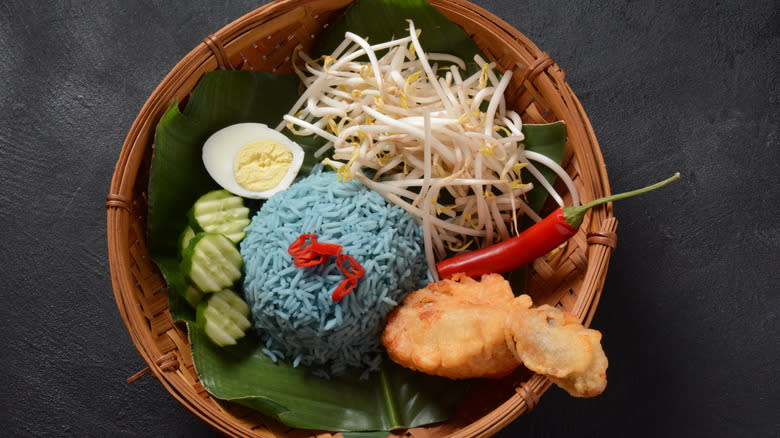
Nasi kerabu is well-known for its striking blue rice, which gets its vibrant hue from the butterfly pea flower. These days, blue dye is also often used to color the dish. The rice is also frequently cooked with a range of ingredients like ginger, turmeric, and lemongrass, and tossed with crispy coconut shavings.
Nasi kerabu is served with a variety of side dishes, such as shrimp crackers, fried chicken, and pickled vegetables. One of the more popular sides is flaked grilled fish fried with ginger, shallots, and grated coconut. Another side that's frequently served with nasi kerabu is a fragrant herb salad made with freshly shredded veggies, cabbage, long beans, bean sprouts, and betel leaf. Nasi kerabu typically comes with two condiments: a shrimp paste known as belacan and budu, a mixture of coconut fish flakes and fermented fish sauce.
The story of nasi kerabu likely began in Malaysia's northeastern state of Kelantan in the 15th century. The colorful dish is a hallmark of the Kelantanese Peranakan cuisine, which combines Malay, Thai, and Chinese flavors. At the time, Chinese and Thai people settled in the area, bringing with them their culinary traditions and ingredients, which then melded with the local Malay culinary practices.
Roti Canai
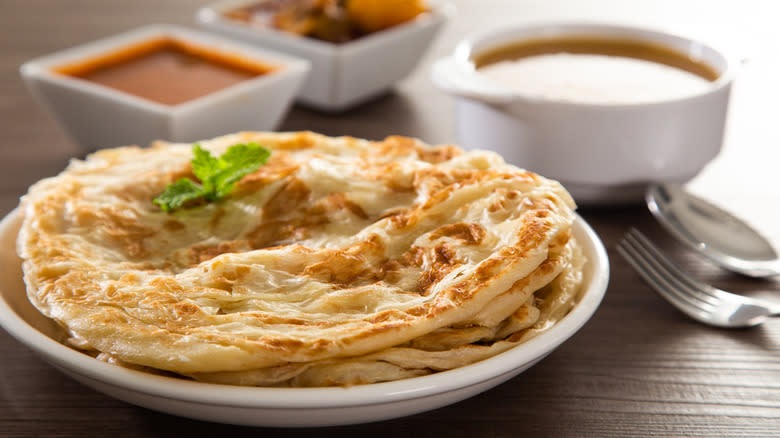
Roti canai is a Malaysian flatbread renowned for its flaky texture. The dish's unique structure is the result of an intricate process of folding the dough with a fat like butter or oil. Known as roti prata in Singapore, this circular bread is usually prepared with ghee or clarified butter. Roti canai is typically served with curry, and while any curry will do, the dish is often accompanied by dal or lentil curry.
While roti canai is a firm favorite among Malaysians, the dish is said to have originated in Southern India, where many Malaysian Indians have ancestral ties. The term "roti" in Malay means bread. However, the word "canai" might be a reference to the city of Chennai in Southeastern India. Then again, canai also means to roll or knead in Malay, indicating that the bread's name could describe its preparation method. This theory gains credence given the difficulty of finding roti canai in India.
Laksa
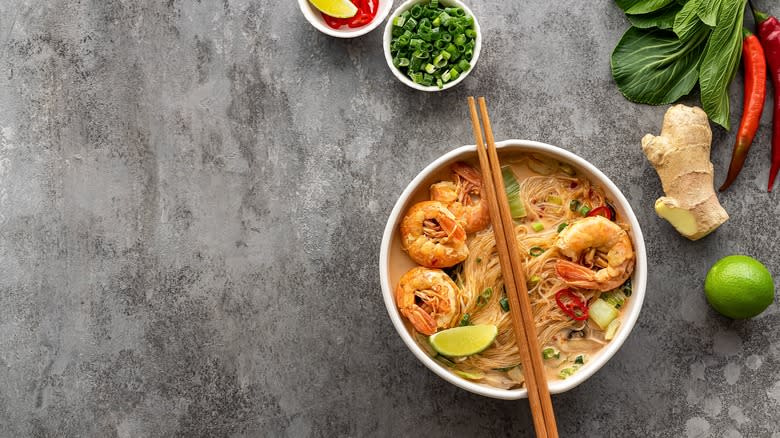
Just like Vietnamese pho and Thai tom yum, Malaysian laksa has gained popularity around the globe, and for a great reason. The creamy soup is known for its delicious fusion of flavors, including spicy, sour, and savory. Made with a coconut-infused broth and noodles, laksa has many regional variations across Malaysia, which makes it appealing to a range of palates.
Once called the "breakfast of gods" by celebrity chef Anthony Bourdain on his Instagram, sarawak laksa is infused with lemongrass, galangal, chilies, garlic, lime juice, and sambal belacan, a spicy shrimp paste. Another popular laksa variety comes from Penang. Known as asam laksa, it is made with ginger, tamarind, and mackerel. It's also commonly garnished with flavorful fruit and herbs, including pineapple, cucumber, and mint. The most ubiquitous laksa found in Malaysia's capital, Kuala Lumpur, is curry laksa. Just as its name suggests, the hearty dish is made with curry paste, as well as laksa leaf, prawns, chicken, puffy tofu, and fish balls.
Hainanese Chicken Rice
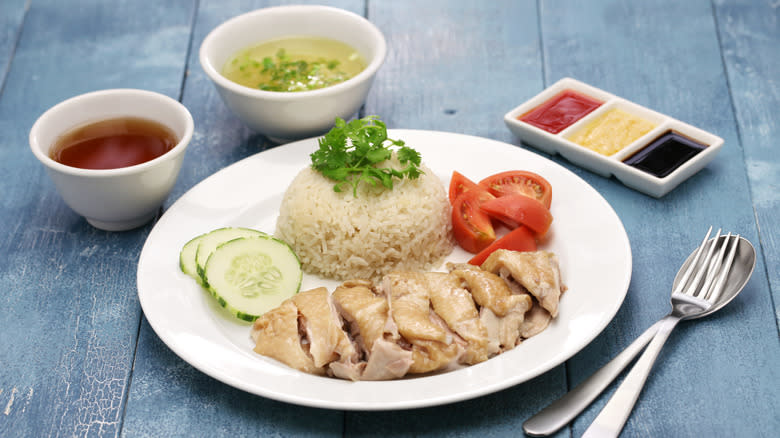
Although Hainanese refers to Hainan, a province in China, many consider Hainanese chicken rice to be a Malaysian specialty. Its origins can indeed be traced back to Hainan, where a similar dish known as Wenchang chicken exists, but it was Hainanese immigrants who invented the version we know today. While both Singapore and Malaysia have laid claim to Hainanese Chicken rice, the true story is anybody's guess. The culinary feud between the two countries reached a striking moment in 2009 when Malaysia's tourism minister, Ng Yen Yen, called Hainanese chicken rice "uniquely Malaysian" and accused Singapore of appropriating the dish (via South China Morning Post).
Living up to its straightforward name, Hainanese chicken rice is fundamentally made of chicken and rice. The preparation of the dish starts with poaching the chicken in chicken stock. Once cooked, the chicken is submerged in ice water, a step that both stops the cooking process and creates a delicate jelly-like layer beneath the poultry's skin. Meanwhile, the rice is cooked in a broth prepared with chicken stock, sauteed garlic, and pandan leaves. Chicken oil — rendered from chicken fat and skin — is also sometimes added to the concoction to enhance its flavor.
Char Kway Teow
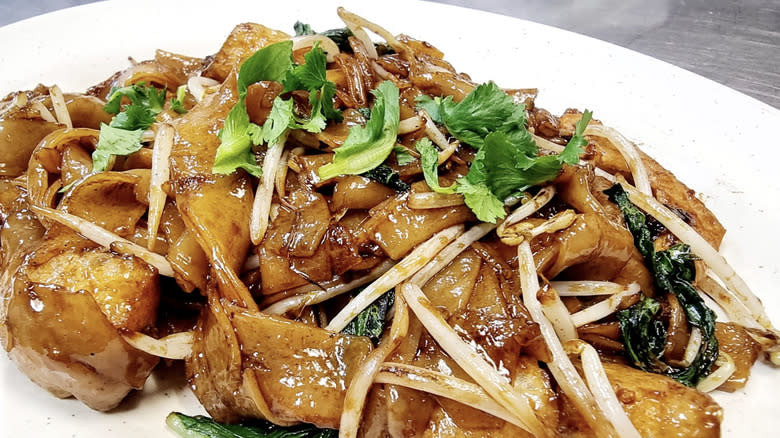
A popular specialty found on most street corners of Malaysia, char kway teow is a noodle dish made with wide, flat rice noodles. The stir-fried dish is commonly prepared with prawns, cockles, Chinese sausage, bean sprouts, and chili, as well as a blend of dark and light soy sauce. The ingredients are tossed around in a wok on high heat, which imparts the dish with a distinct smoky flavor and aroma, often referred to in Cantonese as wok hei or the breath of the wok.
Char kway teow is also a beloved staple in Singapore, leading to frequent debates between the two nations over the dish's origins. Regardless of the true story, the prevailing opinion is that char kway teow was invented by Teochew migrants from China in the Malaysian state of Penang. It was also the Hokkien and Teochew migrants who introduced flat noodles and distinctive wok frying methods to the Southeast Asian region — both of which play a crucial role in this dish.
Cendol
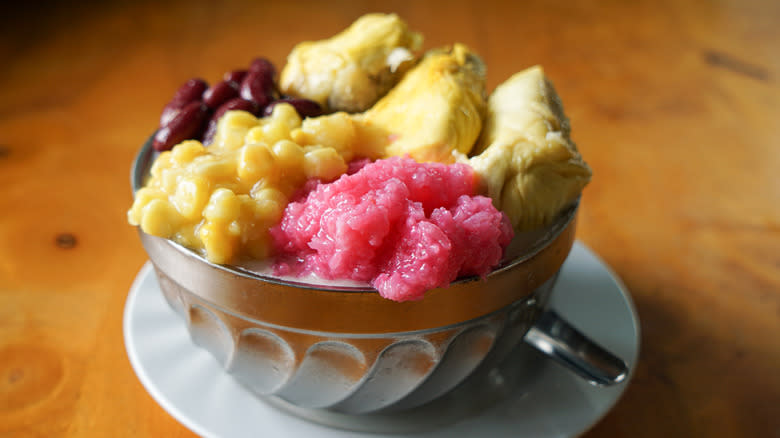
Cendol is hard to miss. The striking Malaysian dessert is known for its distinctive green jelly noodles, which are made from rice flour and pandan leaves. These noodles are served in a bowl of shaved ice and drizzled with coconut milk and palm sugar syrup. This refreshing and creamy treat is sometimes also garnished with additional ingredients such as red beans, durian, and corn.
While cendol is a beloved Malaysian dish, its origins are uncertain, with several Southeast Asian countries claiming it as their own. It's most likely that the dessert was first developed in Indonesia. Historical records suggest that versions of cendol might have already existed during the reign of the Kediri kingdom in 12th-century Java, evolving with the introduction of new ingredients. The dessert is said to have been transplanted to Malaysia by Javanese merchants sometime in the 19th century. Meanwhile, British colonial traders supplied the country with ice, making it possible for cendol to be served in its now-famous icy form.
Rendang
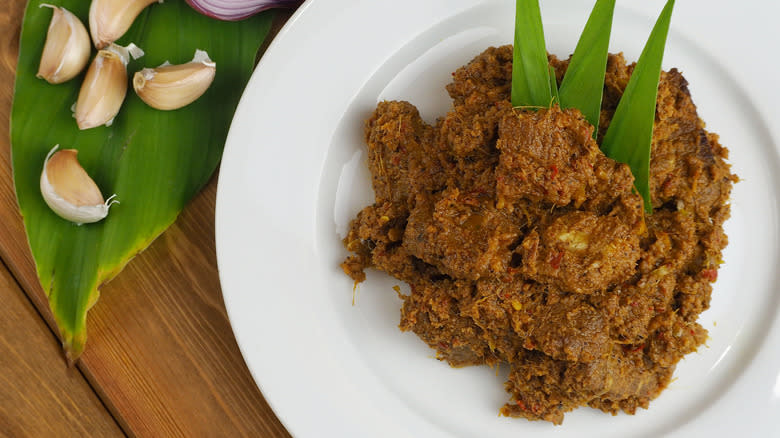
If any food is worth fighting over, it's rendang. Malaysia and Indonesia have a long-standing rivalry over this savory beef dish, with each claiming it as their culinary masterpiece. While the dish is both popular and ubiquitous across the Malay Peninsula, many agree that its origins trace back to the Minangkabau people of Western Sumatra in Indonesia. Nevertheless, rendang remains a Malaysian staple that continues to be celebrated and enjoyed by people across the country.
So, what's all the fuss about? Essentially rendang is a beef curry that's prepared by simmering chunks of meat in an aromatic sauce made from a concoction of coconut milk and spices. These commonly include galangal, lemongrass, ginger, shallots, makrut lime leaves, turmeric, and chili. The slow cooking process tenderizes the beef and thickens the sauce to a velvety consistency. While rendang is typically made with beef, it's sometimes also prepared with chicken or mutton.
Bak Kut Teh
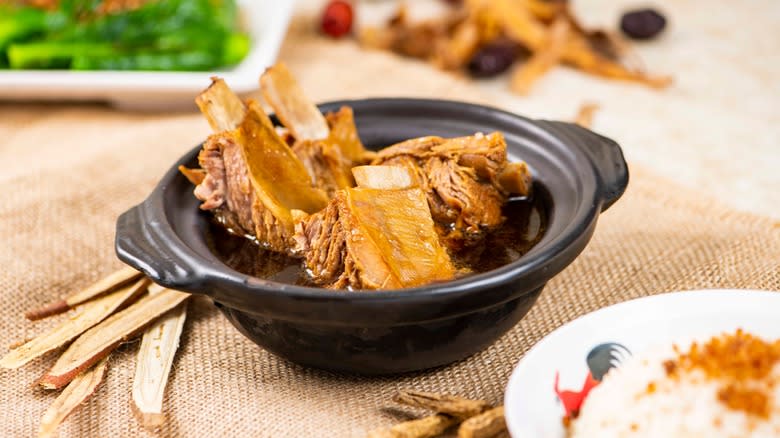
Found at both restaurants and street stalls, bak kut teh is a filling pork soup renowned for its fragrant broth and bold flavor. The dish usually comes with different pig parts, including ribs, bones, and belly, which are simmered in a concoction of herbs and spices. Among these are star anise, angelica root, and processed rehmannia root. Bak kut teh comes in three different types: the herby Cantonese style, fragrant Hokkien style, and peppery Teochew style. The soup is usually served with tea — "teh" means tea in Malay.
Even though Malaysia and Singapore each argue that they are the birthplace of bak kut teh, there's no conclusive evidence of the dish's origins. Nevertheless, it's most likely that the dish was transported by Chinese immigrants from the Fujian province, establishing roots in both countries. According to Malaysia's version of the story, bak kut teh was invented in the city of Klang by Hokkien migrants from Fujian in the 19th century. Since many of them worked at the city's port as laborers, they used the soup to boost their energy levels and minimize the risk of health issues such as arthritis.
Mee Goreng Mamak
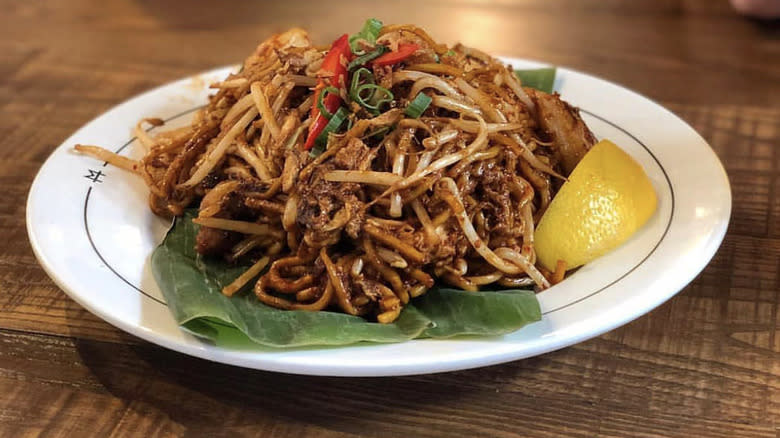
Celebrated within the Indian Muslim — or Mamak — community in Malaysia, mee goreng mamak is a stir-fried noodle dish that perfectly captures the multicultural nature of the country's cuisine. The dish is typically served at roadside stalls and mamak restaurants that are open late into the night or even 24/7. While mamak eateries don't serve alcohol, they are famous for their teh tarik, a tea drink with condensed milk that's poured between two containers until it becomes smooth and frothy.
Mee goreng mamak is made with fresh yellow noodles, as well as ingredients such as bean sprouts, boiled potatoes, fried tofu, garlic, and red chilies. The addition of eggs, either scrambled into the noodles or served sunny side up on top, complements the dish's spicy and savory flavor. While the ingredients for the sauce vary between recipes, the noodle dressing is usually composed of soy sauce, sweet soy sauce, ketchup, and granulated sugar. The sauce sometimes also includes Malaysian curry powder and sambal chili paste for an extra kick.
Ayam Percik
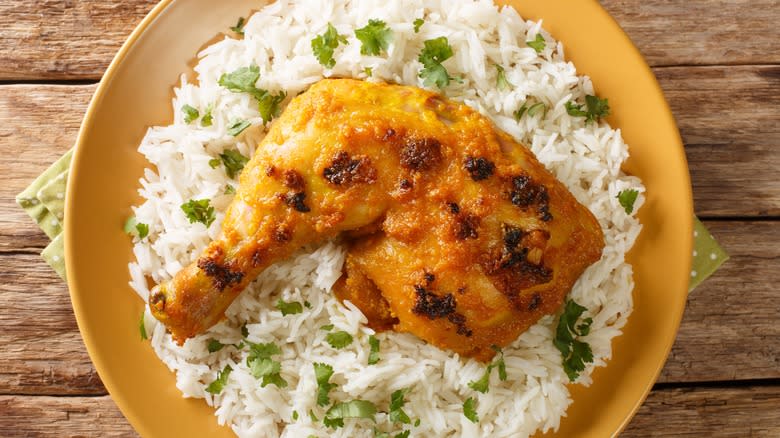
Not just another grilled chicken dish, ayam percik abounds with a rich flavor and aroma that distinguishes it from other poultry dishes. The most important part of preparing ayam percik is the marinade, which combines a plethora of ingredients that imbue the chicken with its signature taste. These typically include coconut milk, lemongrass, turmeric, tamarind paste, ginger, and chilies. The marinade gives the chicken a deep flavor profile that's simultaneously spicy, sweet, sour, and umami. Ayam percik is traditionally roasted over coals, a practice that imbues it with delicious smoky notes.
Ayam percik is believed to have originated in the northeastern Malaysian state of Kelantan. The dish derives its name from its preparation method. While the word "ayam" means chicken in Malay, the term "percik" translates to splatter, a reference to the marinade that's continuously splashed on the chicken as it grills. Over time, the satisfying dish has evolved from a regional specialty into a national favorite. Today, ayam percik is often served alongside rice or as a side to other Malaysian specialties such as nasi lemak and nasi kerabu.
Ais Kacang
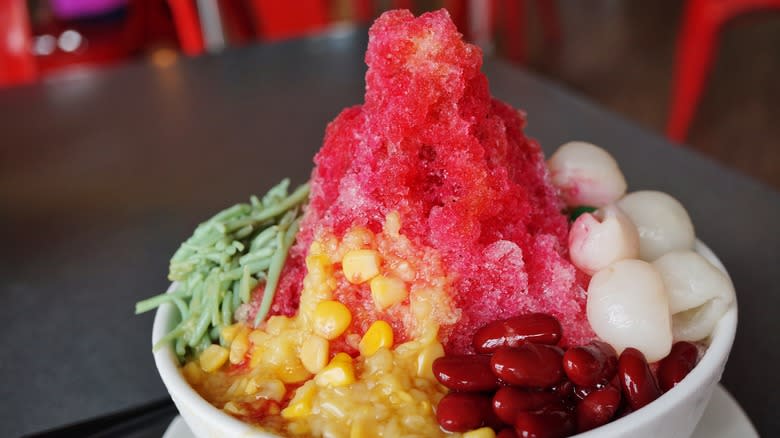
Ais kacang is a captivating Malaysian dessert that stands out for its striking combination of flavors, textures, and colors. The sweet treat is made with a base of shaved ice, which is generously topped with an array of ingredients, such as red bean paste, grass jelly, and sweet corn. Finally, the dessert is drizzled with condensed milk, as well as a combination of sweet syrups such as palm sugar syrup and rose syrup. Also called ABC (air batu campur), the modern version of ais kacang features regional variations. For instance, in Penang, ais kacang usually comes adorned with durian, while in Sabah and Sarawak, the dish is commonly accompanied by mango and sago pearls.
The roots of ais kacang can be traced back to the Peranakan people of Malacca, who used to enjoy a simple dessert made with shaved ice and red bean paste. Not surprisingly, the word "ais" translates to ice in Malay, while the term "kacang," refers to beans. The refreshing dish evolved, and today is popular across Southeast Asia, particularly in Singapore, Indonesia, the Philippines, and Thailand, where it goes by a variety of different names.
Kuih
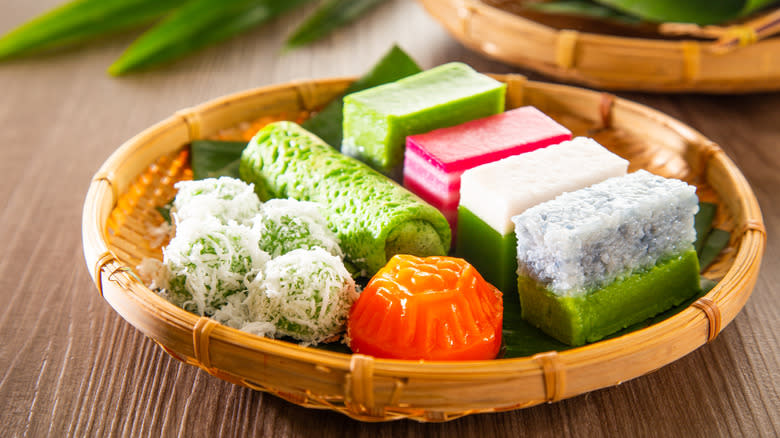
Rather than representing one dish, kuih encompasses a variety of traditional Malaysian snacks, which are often sweet, but can also be savory. These treats are deeply rooted in the gastronomic heritage of Malaysia, encapsulating the culinary traditions of the country's different ethnic groups. While kuih-style cakes also exist in other Southeast Asia countries, Malaysian kuih find their roots in the Peranakan or Nyonya culture of early Chinese settlers who migrated to Malaysia during the era of the Malay Sultanates in the 15th and 16th centuries.
Today, the colorful bite-sized snacks can be enjoyed at both bustling street markets and in upscale dining establishments. One of the most iconic Malaysian kuih is the ang ku kuih, which features a chewy orange exterior and a mung bean paste filling. Then there's the vibrantly green kuih bakar with a custardy interior and a slightly crispy, caramelized top. Another notable kuih is kuih kacang merah, a red-hued cake made with red beans, pandan, and coconut milk.
Penang Hokkien Mee
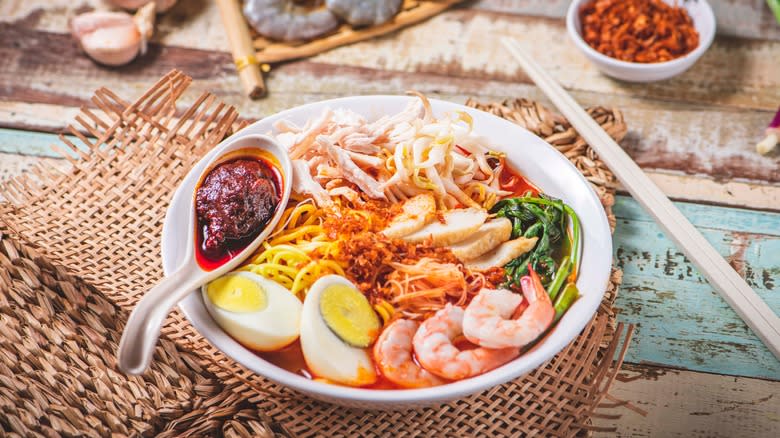
The name Penang Hokkien mee embodies tthis dish's rich heritage. The spicy noodle soup traces its roots back to the Malaysian state of Penang, where a vibrant fusion of Hokkien and Malay culinary influences converged to create this beloved dish. Referred to as simply Hokkien mee in Penang, an early version of the dish probably arrived in the province with Hokkien migrants from the Fujian province of China.
Penang Hokkien mee combines a rich and fragrant broth with ingredients such as prawns, hard-boiled eggs, and pork. More specifically, the broth is made by simmering prawn heads and shells, pork, chicken stock bones, and spicy sambal. While Penang Hokkien mee is ubiquitous in its state of origin, Kuala Lumpur has its own version of the dish, made with stir-fried noodles, dark soy sauce, seafood, lard, and pork liver. Singapore also has its own take on Hokkien mee, made with pork stock, pork belly slices, eggs, and seafood.
Read the original article on Mashed.

